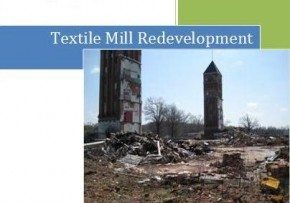
In South Carolina, textile mill production and employment peaked in the 1970s and declined rapidly through the 1980s and 1990s. The impact of global economic forces has been widespread and particularly hard-felt in the Carolina Upstate. The smallest and mostly rural communities of the Catawba Region, in particular, have yet to recover from fully—even 20 or more years later.
As we enter the second decade of the 21st Century, there is little optimism that the textile industry will return to these facilities. Many have already fallen into disrepair or have been ravaged by out-of-town salvage companies that leave piles of debris and scores of unfulfilled promises. The sheer size of the mill buildings and grounds add to the potential for blight. To further complicate the situation, local governments are facing dire financial times due to the national recession and high rates of unemployment and home foreclosures. What then is to become of these properties?
Catawba Regional has been involved in the successful redevelopment of multiple textile/brownfield projects that leveraged federal, state and local funds. These projects produced positive changes on blighted, textile/brownfield properties. Since 2000, Catawba Regional has managed 17 textile related projects for the localities in the region which were funded with state and federal agencies and funding sources, including the SC Department of Commerce, Housing and Urban Development (CDBG and HOME), US Environmental Protection Agency, USDA Rural Development Program, and SC Department of Health & Environmental Control.
Through the support of the SC Department of Commerce, Catawba Regional received Community Development Block Grant (CDBG) funding in December 2010 to prepare this Textile Mill Redevelopment Guide. The guide will provide a resource for the clean-up and redevelopment of these brownfield sites in the Catawba region in order to improve economic viability in low and moderate income areas. Local officials in South Carolina can use the techniques and resources compiled in this easy to read and understand resource for addressing brownfield redevelopment options specific to textile mills. The anticipated date of completion is December 2011. Contact Robby Moody at 803.327.9041 for more information.

 (803) 327-9041
(803) 327-9041
